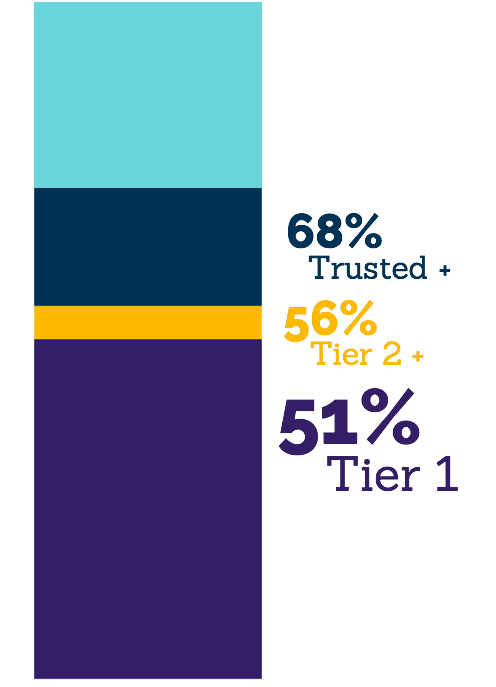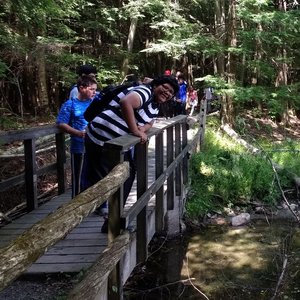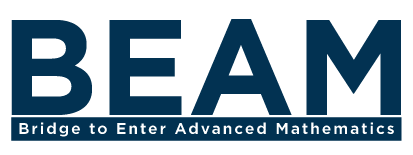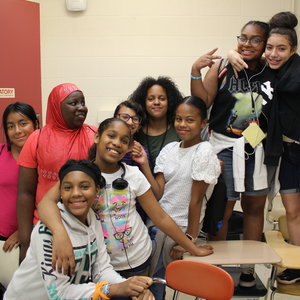BEAM students are on the pathway toward STEM success.
Explore the statistics below to see how they are beating the odds.
Over 80% of our 2018 college bound cohort enrolled in selective colleges according to Barron’s Profile of American Colleges, including Yale, Northwestern, Cornell, and more. BEAM’s oldest cohort, BEAM 2011, are now juniors in college, so we will not have 4-year graduation rates until 2020 (and some students may take five years to graduate college). In the interim, we track college admissions and major declaration to ensure students are on track to college graduation.
Here are the outcomes for the 34 of the students in the BEAM 2013 cohort, our most recent cohort to graduate high school:

We measure interest in math through surveys administered during the summer. In 2018, at least 85% of students at each summer site (including both BEAM Discovery and BEAM Summer Away) reported that they were more interested in math after the summer. Our students also continue to engage with math throughout the year. Fifty-two percent of students from BEAM Discovery 2018 choose to spend their free time on BEAM-provided math problems, online math classes, or other enrichment opportunities we recommended. during 2018-2019 school year
In New York City, BEAM examines high schools to determine which schools provide the best foundation for STEM college study. These schools, which we label Tier 1 high schools, offer Calculus and ensure that students graduate ready for college. Tier 1 high schools include: all specialized schools in NYC (such as Stuyvesant, Bronx Science, Brooklyn Tech); Bard High School Early College; the Beacon School; Midwood High School; Townsend Harris High School; Millennium High School; Manhattan/Hunter Science High School; and Manhattan Center for Science and Mathematics, all schools that BEAM students attend. Here are our NYC high school admission results for 2018:

Over 80% of our 2018 college bound cohort enrolled in selective colleges according to Barron’s Profile of American Colleges, including Yale, Northwestern, Cornell, and more. BEAM’s oldest cohort, BEAM 2011, are now juniors in college, so we will not have 4-year graduation rates until 2020 (and some students may take five years to graduate college). In the interim, we track college admissions and major declaration to ensure students are on track to college graduation.
Here are the outcomes for the 34 of the students in the BEAM 2013 cohort, our most recent cohort to graduate high school:

We measure interest in math through surveys administered during the summer. In 2018, at least 85% of students at each summer site (including both BEAM Discovery and BEAM Summer Away) reported that they were more interested in math after the summer. Our students continue to engage with math throughout the year. Fifty-two percent of students from BEAM Discovery 2018 spend their free time on BEAM-provided math problems, online math classes, or other enrichment opportunities we recommended. during 2018-2019 school year
In New York City, BEAM examines high schools to determine which schools provide the best foundation for STEM college study. These schools, which we label Tier 1 high schools, offer Calculus and ensure that students graduate ready for college. Tier 1 high schools include: all specialized schools in NYC (such as Stuyvesant, Bronx Science, Brooklyn Tech); Bard High School Early College; the Beacon School; Midwood High School; Townsend Harris High School; Millennium High School; Manhattan/Hunter Science High School; and Manhattan Center for Science and Mathematics, all schools that BEAM students attend. Here are our NYC high school admission results for 2018:
College Bound
Over 80% of our 2018 college bound cohort enrolled in selective colleges according to Barron’s Profile of American Colleges, including Yale, Northwestern, Cornell, and more. BEAM’s oldest cohort, BEAM 2011, are now juniors in college, so we will not have 4-year graduation rates until 2020 (and some students may take five years to graduate college). In the interim, we track college admissions and major declaration to ensure students are on track to college graduation.
Here are the outcomes for the 34 of the students in the BEAM 2013 cohort, our most recent cohort to graduate high school:

Captivated by math
We measure interest in math through surveys administered during the summer. In 2018, at least 85% of students at each summer site (including both BEAM Discovery and BEAM Summer Away) reported that they were more interested in math after the summer.
Our students also continue to engage with math throughout the year. Fifty-two percent of students from BEAM Discovery 2018 choose to spend their free time on BEAM-provided math problems, online math classes, or other enrichment opportunities we recommended. during 2018-2019 school year
College Ready
In New York City, BEAM examines high schools to determine which schools provide the best foundation for STEM college study. These schools, which we label Tier 1 high schools, offer Calculus and ensure that students graduate ready for college. Tier 1 high schools include: all specialized schools in NYC (such as Stuyvesant, Bronx Science, Brooklyn Tech); Bard High School Early College; the Beacon School; Midwood High School; Townsend Harris High School; Millennium High School; Manhattan/Hunter Science High School; and Manhattan Center for Science and Mathematics, all schools that BEAM students attend. Here are our NYC high school admission results for 2018:

John’s Story
“Beam has done so much for me. BEAM Summer Away was my first time away from home. I was scared; my parents were unsure, too. But the program was awesome! Marcus’s logic class really challenged me. Marcus is the kind of teacher who will let you struggle. Because he let me figure things out for myself, when I eventually understood how to reason through a problem, I was really proud. I also met Quentin at Summer Away, and he’s still one of my closest friends. Later, BEAM helped me get into Bard High School Early College, which I wouldn’t have even known about without BEAM. At Bard, I earned my Associate’s Degree. Then, when I was applying to college, Ruthi helped me write and rewrite my essay, and really made it better. Now that I’m at Fordham, Ayinde has taught me how to advocate for myself with the financial aid office and how to talk to my teachers when I’m having problems. This past summer was my fourth year as a counselor at BEAM. I love being able to give back to the students. It’s so rewarding to see their faces when they finally understand a problem. I love building such great bonds with the kids, just like I created with my own counselors.” John Embaba is majoring in chemistry on the premed track at Fordham University. He attended BEAM Summer Away at Bard College in 2012.
Measuring mathematical growth
BEAM begins with summer programs for rising 7th and 8th graders (BEAM Discovery and BEAM Summer Away, respectively). BEAM aims to measure two areas of student growth during the summer:
- Mathematical problem solving (generally through pre-tests and post-tests).
- Persistence and interest in mathematics.
We assess mathematical growth using math contests, the best tool we have found to measure problem solving at the level of BEAM instruction. Using math contests, we see how students’ starting and ending scores compare to students who are already advanced in mathematics. Generally, only top math students even take these exams, and they are largely from affluent backgrounds.
Problem solving at BEAM Discovery
BEAM Discovery uses the Math League contest to measure growth. The chart below summarizes the median student’s national placement at the beginning of the summer and the end.
 From this table, it is apparent just how far behind our students begin as compared to affluent peers, but also how much progress they can make in five weeks!
From this table, it is apparent just how far behind our students begin as compared to affluent peers, but also how much progress they can make in five weeks!
Problem solving at BEAM Summer Away
BEAM Summer Away uses the American Mathematics Competition (AMC) 8 to measure growth. The chart below summarizes the median student’s national placement at the beginning of the summer and the end.

Persistence: “What's the longest you've spent on a math problem?”
In addition, we measure student stamina on problem solving by tracking the longest students have spent solving a single math problem, asking this question at the start and end of each summer. Before BEAM Discovery, the median answer was 30 minutes. By the end of BEAM Discovery, it became 2 days!
About BEAM
Beam opens your eyes to more than just math. It opens your eyes to patterns, conjectures and making new friends is always a good thing. - Kiara, BEAM Summer Away 2018
It is an amazing program and the math is fun challenging. It is a special opportunity. - Khaylynn, BEAM Discovery 2018
It is an amazing oportunity, you will meet new friends, and before you know it, you are a family. - Angie, BEAM Summer Away 2018
BEAM will help me achieve my goals in life because…

I feel more confident in myself - Edilson, BEAM Discovery 2018
They supported me - Asiel, BEAM Summer Away 2018 Union
It helped me not doubt myself and it made me try new things which I would continue doing. – Malane, BEAM Discovery 2018








